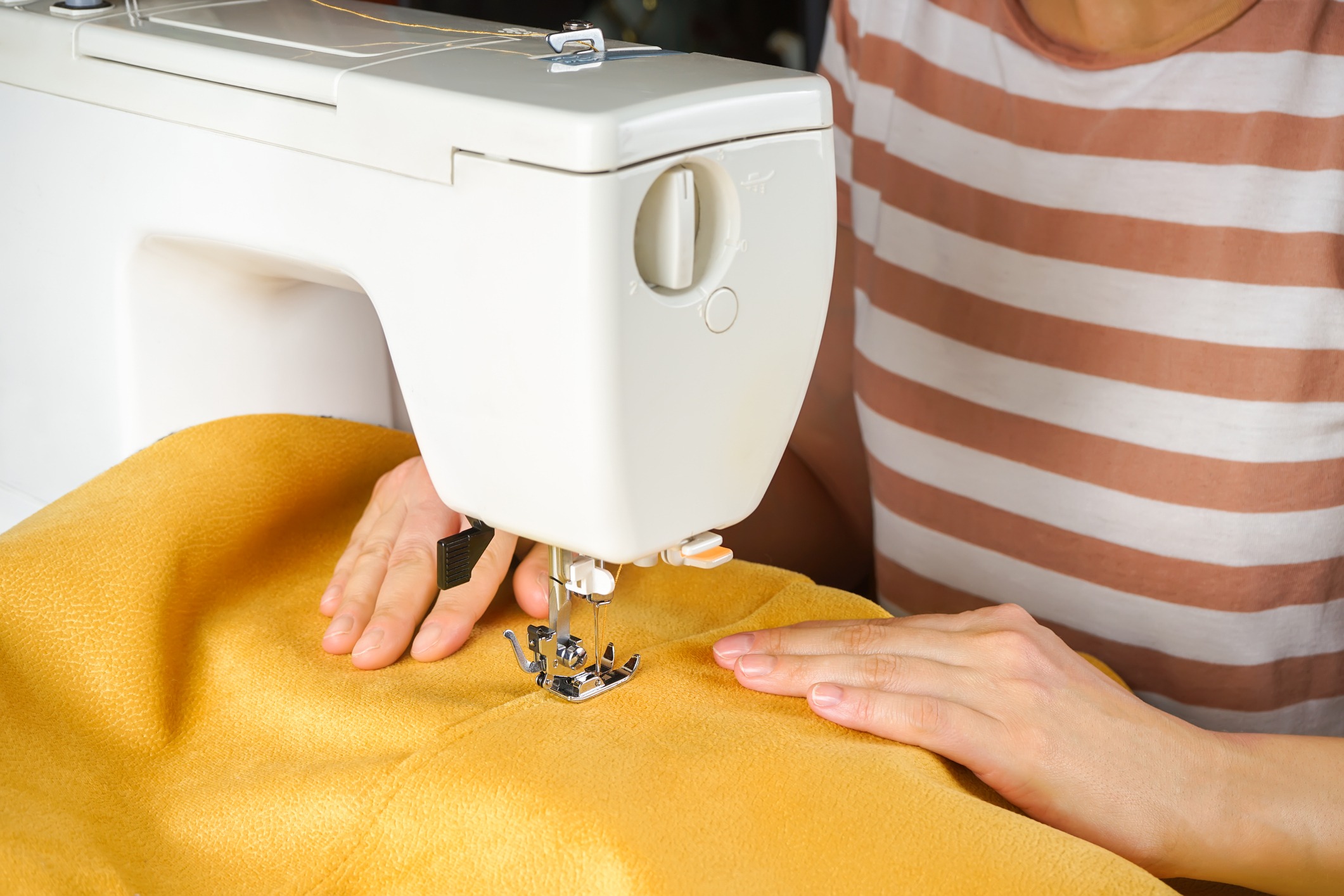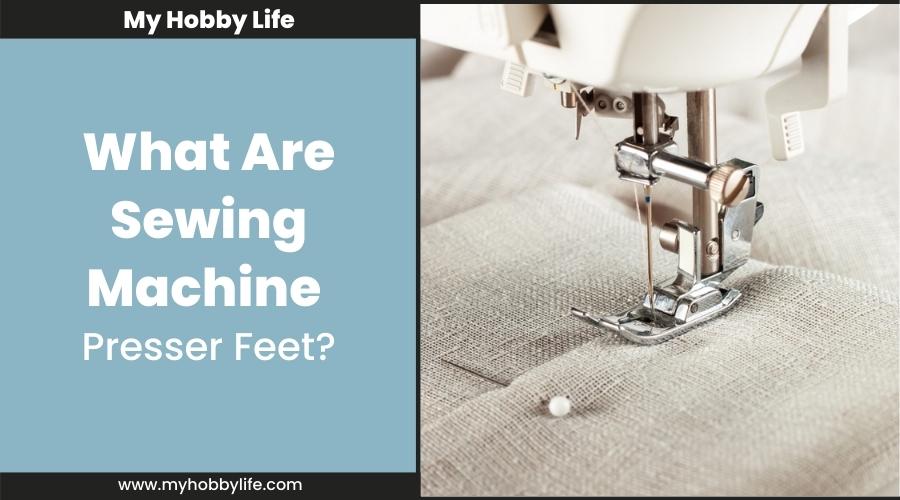Knowing about and understanding the basic components of a sewing machine will help you operate the device a lot better. This time, we are talking about the sewing machine presser feet. A sewing machine presser foot is a small attachment whose primary function is flattening and smoothening the fabric as it is fed through the machine and stitched.
There are various types of sewing machine presser feet that offer other functions. Hence, their additional features offer more conveniences, such as different sewing options. The presser feet will also save you a lot of time!
You won’t probably have to use all types, so we have picked only the specific presser feet that you will find the most useful in your sewing activity.

Presser feet types
1) Straight stitch
Key feature: Basic straight-line stitching
The straight stitch presser foot presents an unusual shape because of its extended left toe. Not only it helps in keeping the fabric firmly in one place, but it also keeps your fingers safe.
Straight stitch is the most basic of all presser feet. It is ideal for straight-line stitching, which is why it is extensively used for stitching regular seams.
2) Zig-zag presser foot
Key feature: Decorative stitching
The zig-zag presser foot works almost like a multi-functional presser foot. That is to say, specifically, you would never need a straight stitch foot if you already have the zig-zag foot.
It neatly and perfectly stitches straight lines that you can use it for the seams. But its chief purpose is creating decorative stitches without much complexity in arranging the fabric around the sewing machine.
3) Zipper or piping presser foot
Key feature: Zipper sewing – sews close to the zipper teeth
If you want to include zippers to your clothes, then you must use the zipper presser foot (or piping presser foot).
This type of presser feet allows you to sew extremely close to the zipper teeth without damaging anything. Furthermore, you can even sew to the right or left of the zipper teeth. Simply position the zipper presser foot accordingly.
You can even use this presser foot to sew piping along the cord inside of the zipper – that too very closely and with an excellent finish.
4) Invisible zipper foot
Key feature: Stitching a concealed zipper
The invisible zipper foot’s biggest flex is that when you use it to sew on the seam, it does not betray the zipper opening at all! It means that the stitching disappears into the seam while also giving you a fantastic opening.
5) Hemmer zipper presser foot
Key feature: Creating straight or curved fabric edges
The chief purpose of this type of presser foot is to finish your clothes with a curling edge, particularly if the fabric you have tends to fray too much. The hemmer zipper presser foot is used in combination with a straight or zig-zag foot. While the hemmer foot guides the edge of the fabric into a nice and proper curl, the straight or zig-zag foot is used to do the stitching.
Another type of hemmer zipper presser foot does a different function, although it does share the same appearance to some extent. Rather than a curl, this other type of hemmer zipper is used to flatten the hem. The only thing missing from this foot is a groove found on the round or curling hemmer foot.
6) Buttonhole presser foot
Key feature: Stitching buttonholes
Are your hands getting tired from making buttonholes on your clothes over and over? Then the buttonhole presser foot will relieve your burdens. Its primary function is to create buttonholes in the fabric.
Compared to other types of presser feet, the buttonhole looks totally different. It is long and has an opening in the middle where you decide on the buttonhole setting and spacing.
7) Open toe embroidery (or open toe presser foot)
Key feature: Decorative stitching and embroidery
If you are a fan of decorative stitching and embroidery, choose this type of presser foot. It offers convenience for many sewing and embroidery enthusiasts. The open toe embroidery foot allows you to create broad and decorative stitches easily. It also saves you time compared to doing decorative stitching and embroidery by hand.
This presser foot is also adapted to its function through a wide opening found at the front of the foot. Furthermore, the plastic variant of this presser foot provides a clearer vision, resulting in better stitching.
8) Quilting
Key feature: More precise and neat quilting
Specifically used for quilting, this type of presser foot allows you to sew the fabric accurately with a seam allowance of ¼ to 1/8 inches. The marking on the presser foot helps you pivot accurately, as well as create straight stitches.
Factors to consider before buying a presser foot
Like with many other components of a sewing machine, buying a presser foot requires careful thought and consideration. It’s no doubt that a presser foot offers many advantages. But before heading to a store to buy one, you must consider a couple of pointers first:
1) Your sewing machine – high shank or low shank?
The shank is a metal rod connecting the presser foot onto the sewing machine. The height of the shank is either “high” or “low.” Most domestic sewing machines have the low shank, while the more expensive and high-end models have the high shank. So, you need to make sure whether you have a low or high shank sewing machine before buying a presser foot.
2) Snap-on or screw-on presser foot?
There are two categories of presser feet:
- Snap-on presser foot – It will typically work with both low and high shank sewing machines with the appropriate maximum stitch width.
- Screw-on presser foot – It will only work with low or high shank sewing machines depending on the machine type or model. However, you can turn a high shank machine into a low shank model with the help of an adaptor (but you can’t do it the other way around).
Thus, you must familiarize yourself with your sewing machine’s structure before purchasing presser feet. Remember that not every presser foot will attach to it.
3) The type of your sewing machine
It is a smart thing to look up your sewing machine manual before buying presser feet. Some presser feet are not compatible with specific sewing machines – either they will not strap nor work. For additional help and assistance, any vendor or store clerk at a shop near you can help you figure out which presser feet will be the most compatible with your sewing machine.
Conclusion
Presser feet are the key components of a sewing machine for premium stitching. They help you make accurate stitches and offer a vast horizon to experiment with different kinds of stitches.
But despite their advantages and tempting nature, it is important to do your research before buying a presser foot. Make sure you know which presser feet will attach and work with your machine before purchasing.
